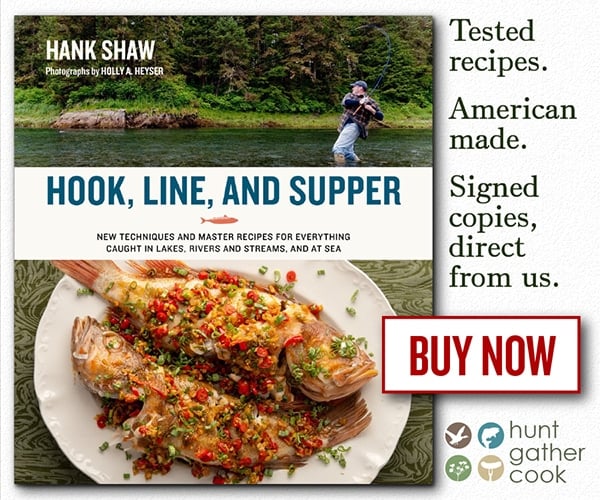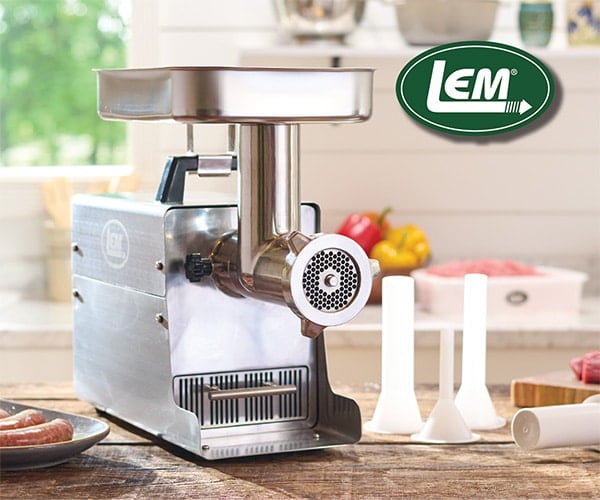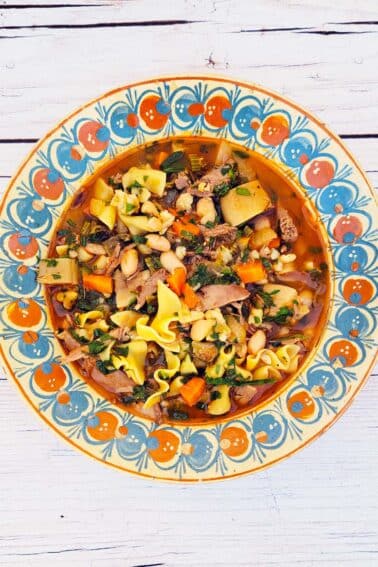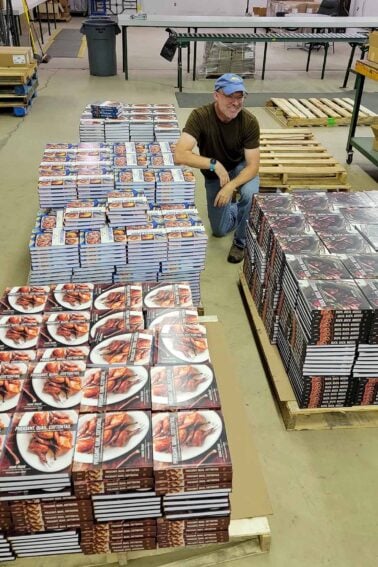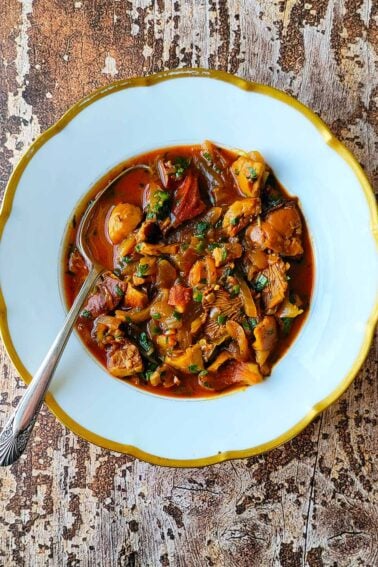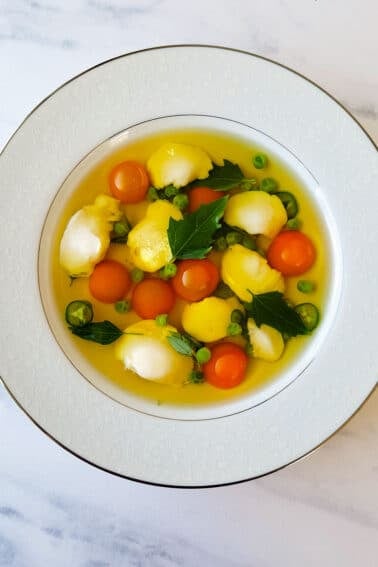As an Amazon Associate I earn from qualifying purchases.

UPDATE: After a spirited discussion on the original version of this post, I am revising it to focus on those areas where sous vide does work well with wild game and fish. ~ Hank
Thanks to cheap immersion circulators, sous vide cooking has swept through the ranks of the wild game world.
I get asked a lot about sous vide and wild game, and, frankly, I am not a huge fan. In most cases, cooking wild game in traditional ways will produce a better result than when it’s cooked in a hot water bath. I’ll go over why in the first part of this article.
There are some areas where sous vide method shines, however, and I’ll get to that at the end of the article.
First off, for those who don’t know, sous vide is highly controlled “boil in a bag,” which you will remember if you are, like me, of a certain age. You seal food inside a bag with a vacuum sealer, then drop it into water of a certain temperature and leave it there until it’s done. More on that later.
I cooked sous vide back when I started as a professional cook, back in the late 1980s. It was OK in a professional kitchen where you are cooking massive volume; we did 120+ covers a night back then. You’d drop fish into the bag with some seasonings and let them hang there during service, ready to be seared at a moment’s notice. A place down the street even did their steaks this way.
But I never loved this method, and neither do most professional cooks I know. I recently polled a number of my chef friends about sous vide, and here are some of their comments:
Frankly, I’m not a fan. I feel like it takes the skill and heart out of cooking. I also tend not to like the textures they produce. Particularly in birds and fish. I’m not all negative on it though. I’ve had great luck with vegetables that have a ton of flavor added by cooking them with a aromatics and fats…
— Aaron Barnett, Moule, Portland, OR
In a world where we chase the illusion of perfection … sometimes we forget the best thing about meat is imperfection. I want a bite of char and “over” meat attached to beautifully pink. Plus there’s no real fire involved in sous vide so I am personally turned off. Smoke and flame equal char and flavor.
— Doug Adams, Top Chef finalist, season 12, Bullard, Portland, OR
As far as game meats are concerned: perfect for hitting precise target temperatures on easy-to-overcook lean meats like deer. Also a great way to really infuse marinades and brines/cures. Great for freezer storage. Minuses: more plastic. People tend to want to sous vide everything.
— Levon Wallace, Nashville, TN
Pluses are consistent temperature control to achieve great results in various meats, finished with a reverse sear. Impeccable egg control, delivering this amazing ingredient with so many levels of texture. Minuses. It’s not very sexy. It takes away the technique of building layers of flavor when creating a braise, and controlling heat and time to achieve greatness in the pan. Cooking a steak over flame and knowing how long to cook and rest is an art itself and is in my opinion better that sous vide.
— Oliver Ridgeway, Camden Spit & Larder, Sacramento, CA
Let’s unpack all that in the context of wild game and fish.
I think we can all agree that sous vide eggs are probably the greatest thing you can cook in this water bath. After all, no bag needed. Just drop the egg in the water and you get soft or hard-boiled or poached eggs perfect every time.
But other proteins? First, there the unsightly bag marks on the food. Note the lines on the side of this poached salmon:
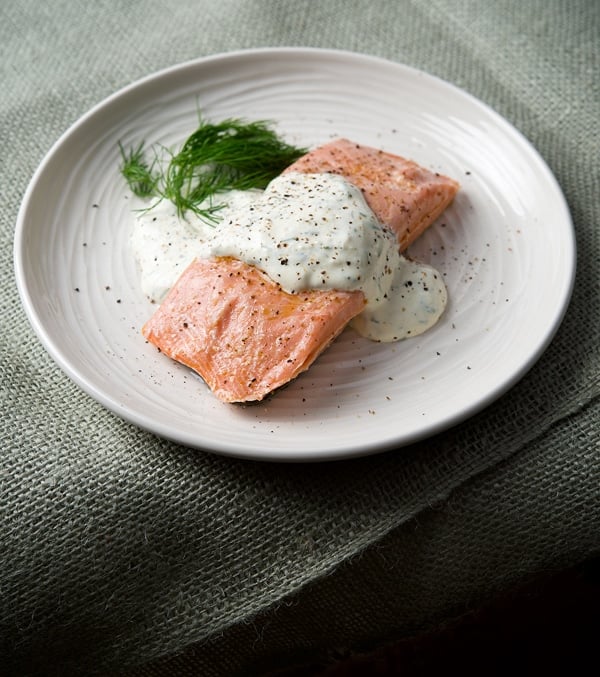
And you can kinda-sorta get around that by not fully sealing your food, but then you leave air inside, and the bag will float, causing uneven cooking.
Texture is a serious issue, as you can read from the chefs’ comments above. It really is true. Sous vide-anything gets a weird, pasty-gummy texture that simply isn’t as nice as traditionally cooked food. This happens especially when you actually do the set-it-and-forget-it thing. So when you do use sous vide, watch your timing. You can always cook something more. You can’t uncook it.
You will almost always need to sear or grill your wild game or fish after it has been in the water bath. If you don’t, your protein will be oddly soggy and waterlogged. Personally I would just use traditional methods to cook a duck breast or grill a venison loin, but if you do sous vide beforehand, remember that the meat is already cooked, so you are looking for very high heat and a very quick sear here.
Another big issue you will need to deal with in the context of wild game is variability. One of the great things about sous vide with store-bought meats is that you can dial in a temperature and time and get consistent results every time. Wild meats are wildly variable. To cook wild game you must embrace the chaos.
How old was that goose? Young of the year? Maybe 30 years old? (Don’t laugh, there have been Canada geese recovered that had been banded three decades prior.) Trophy buck or button buck? Rope-dragger tom or a jake with a nub for a beard?
How large is your cut? Store bought meats are relatively consistent in size. Wild animals are not.
This variability is easily handled in a pot or a pan. Is it done? Lift the lid and check. When you cook sous vide, you would need to either open up your vacuum sealed bag to check, or cook the meat or fish longer. But then you run into issues of texture again. And you’ve defeated the convenience of the cook-in-a-bag method.
You should also know that there are few instances where the precision afforded by sous vide is actually better than a less-precise traditional method.
Confit? Braises? Stew? Shanks? All just fine in a slow cooker or Dutch oven. After all, connective tissue really breaks down starting around 160°F, which just happens to be a steaming (not simmering) pot of water or “low” on a Crock-Pot.
There is one exception that proves the rule, however. Bear. I do like to sous vide bear backstrap at about 140°F for 1 hour, or 145°F for 45 minutes. Note that the internal temp of the meat needs to be at these temperatures for 12 minutes or 4 minutes, respectively. The extra time is to get you there safely. Why? Trichinosis. Not a fan. And this pasteurizes the meat, so you can eat it medium.
OK, if you’re still with me, here’s the payoff. Here’s where sous vide is absolutely useful with wild game and fish:
- First, the aforementioned bear thing. You can pasteurize dodgy meats this way quite effectively.
- Confit. Yes, it is 100 percent not as good as old school French confit. Period, there is no debate. But… even I don’t like the fact that old school French confit requires like 8 cups of fat. Sure, you can reuse it a few times, but still. So packing your confit in a vac bag and putting it in a big stockpot of steaming water — note that there is no techy immersion circulator involved here — works really well and allows you to easily confit in nifty fats like, say, rendered pheasant fat, since you don’t need that much.
- Curing meats and marinating. Similar to the confit, you use less marinade or cure when you can vac seal it… not actually sous vide, but it is a case for vacuum sealing.
- Weirdly, sauerbraten. I’ve done this dish many ways, but the five-day marinade, all vac sealed, and then that marinated venison cooked slowly but at 140°F, still pink but hot enough to break down connective tissue over many hours, and then served with the traditional sauce — so it’s pink venison with that amazing sauce — is worth the loss in texture.
- Cooking potentially tough cuts like corned venison. Set your water bath to 140°F, add spices or fill with broth instead of water, and just drop the meat in to cook. No vacuum bag needed.
- Pâté or terrines, or hell, even regular meatloaf. You fill the water bath up to the neck of the vessel — either a terrine pan, loaf pan or a mason jar — set it at your target temperature and let it ride for a few hours. Incidentally, a regular 2-quart terrine pan will need about 3 hours to get to the ideal temperature of about 148°F to 150°F. Again, no vacuum bag needed.
- Poaching sausages or whatever. Again, no vacuum bag needed, but being able to submerge meat or fish in a flavorful liquid like broth at a precise temperature makes it easier to get a good result.
- Roulades. One of the things about vacuum sealing is compression. And when that is combined with coagulating proteins from cooking, you can get a roulade of, say, venison, that is cooked medium-rare, and that holds it shape.
- It can be used in barbecue, although I will likely never do this. I am too much of a purist. Here’s an article on how to do it. But remember, I have an excellent smoker. If you don’t, and need to use a little Weber or somesuch, time in the water bath beats staying up all night tending the smoke.
Here are some other uses not involving game or fish that are useful:
- We already covered eggs. Sous vide “boiled” eggs are amazing.
- Keeping your container warm enough for yogurt or kombucha or for malting barley. (Hat tip to Chef Ron Zimmerman of Herbfarm in Washington for that one.)
- Heating cream custard bases for ice cream to the exact temperature. (Once again, no vacuum bag needed.)
- If you’re not good at cooking thick, tender pieces of meat, i.e., really thick pork chops, sous vide can be helpful.
- When you are trying to get lots of things ready for the table at once, having the main part of the main course steady and almost ready can be useful. You will still need to sear or grill it right before you serve, and you will still need to be careful of your timing, though.
- Parties. Similar to my previous point, when you are serving a ton of people, use sous vide for the same reason we did in the restaurants: You can hold meats and fish in the water, then open the bag and sear to order. Using your immersion circulator as one more cooking vessel can help a lot when you are cooking for a crowd.
Here’s the deal: Sous vide is like canning. If you can remember when you started canning, you probably canned like 30 jars of peaches that one year, only to find yourself four years later looking at 24 jars of peaches. It’s the zeal of a convert thing. I get it.
So you do you. Sous vide everything feel like. Work through it your own way, and see where this method of cooking really suits your own style.
Bottom line for me? Sous vide is an adjunct to traditional cooking, not a replacement.
